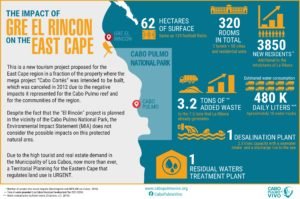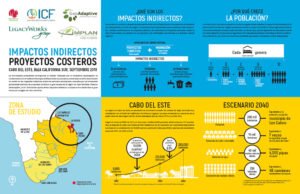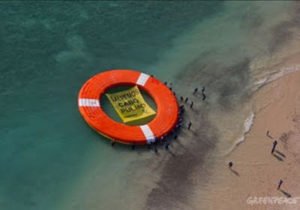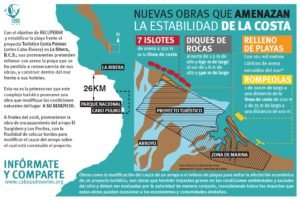Cabo Pulmo is in a region that is changing rapidly, where real estate projects not only lead to population growth, but also more demand for resources such as water, pollution and demand for services that do not yet exist for current communities.
In recent years, dozens of real estate and tourism projects have tried to establish themselves in the Cabo del Este, proposing a model of growth and development that is not compatible with the characteristics of the region and that represent a threat to the ecological balance of the various ecosystems that hosts, including the Cabo Pulmo National Park. They stand out among them:
East Cape GRE El Rincon
“EAST CAPE GRE EL RINCÓN” is the most recent tourism project proposed for the Cabo del Este region in a fraction of the property where the mega project “Cabo Cortés” was intended to be built, canceled in 2012 due to the negative impacts it represented for the Cabo Pulmo reef and for the communities of the region.
Despite the fact that the “El Rincón” project is planned in the vicinity of the Cabo Pulmo National Park, the Environmental Impact Statement (MIA) does not consider the possible impacts on this protected natural area.
Due to the high tourist and real estate demand in the Municipality of Los Cabos, today more than ever, a Territorial Planning for the Cabo del Este that regulates land use is URGENT.
Bahía El Rincón Hotel
In September 2018, the company Planeación y Desarrollos del Cerro, S.A. de C.V. submitted the Environmental Impact Assessment (EIA) of the Bahía del Rincón project to the environmental impact assessment procedure, which envisages the construction of six 235-room buildings, 20 one-level villas and 13 buildings with 75 villas in a vertical condominium, as well as restaurants, a beach club and other tourist-type infrastructure, located within the area of what were once the Cabo Cortés and Cabo Dorado projects, just over three kilometers north of Cabo Pulmo National Park.
Although the project would be established in the vicinity of Cabo Pulmo National Park, considered one of the most precious ecosystems in the world, and which could have direct impacts on its threatened or endangered ecosystems and species, like the leatherback and olive ridley sea turtles, SEMARNAT decided not to grant the Public Consultation of the project, authorizing its construction in December 2018.
Cabo Pelícanos
In April 2016, the company BCS Desarrollos Los Cabos, S.A. de C.V. submitted the Environmental Impact Assessment (EIA) to the Ministry of Environment and Natural Resources (Semarnat) for the approval of the project named “Master Plan of Tourism Development Cabo Pelícanos” which would be located 10 km south of Cabo Pulmo National Park.
This project included, among other things: 1119 hotel rooms (in La Paz alone during 2014 there was an infrastructure of 2812 rooms according to the Ministry of Economic Development, Environment and National Resources), an 18-hole golf course, artificial lakes and a museum-aquarium that included the exhibition of a whale shark.
On 23 June, the public information meeting was held at which the developer presented the project. Civil society organizations also raised concerns about the environmental risk that such a project posed to the park. As a result of this process, SEMARNAT requested the developer to resolve about 70 observations made to the project within a 60-day period.
On August 25 of the same year, the developer declared through an official letter to the Directorate General of Environmental Impact Risk that it abandoned the environmental impact assessment procedure of the project.
Cabo Dorado
A new project emerged in early 2014, which came from a co-investment of Chinese and American origin with support from the China State Construction Engineering Corporation. Cabo Dorado said it was linked to a binational agreement between the presidents of Mexico and China to deepen economic and trade cooperation between the two countries.
Cabo Dorado proposed the construction of a new “ecotourism” Chinese Mexican city with a total of 22,503 rooms, distributed in: 9 hotels, 6,141 homes, 4,380 facilities for commerce, restaurants, services, and condominiums; 100 rooms for infrastructure and equipment services. In addition, the construction of an airstrip, a 14 km aqueduct, 2 golf courses and a practice course, a trade center, a cultural and education center, a technology museum, study and scientific research centers, a high-performance sports center, a wellness center, a visitor center and three beach clubs. All this within an area of 3,770 hectares.
Cabo Dorado has the concessions to extract 4.8 million cubic meters of water annually. Of these, 4.5 million come from the aquifer of Santiago, the only reserve to supply the water demand of current populations. In addition, 315 thousand cubic meters per year will be extracted from the Cabo Pulmo aquifer, whose users already face the challenge of water scarcity.
Cabo Cortés
In 2008, the Spanish company Hansa Urbana intended to build a tourist mega-project in Cabo Pulmo named Cabo Cortés.
This mega-tourism project aimed to build more than 30,000 rooms (between hotels and homes), 3 golf courses, a marina, and an airport just a few meters north of Cabo Pulmo. The intention to build a development of such a scale on the shores of a fragile reef ecosystem is difficult to understand.
Fortunately, and thanks to thousands of citizens, who signed to reject the project, the Government of Mexico revoked the environmental authorization on both occasions, leaving these mega tourism projects without effect.
Our concern is not only about the environment, but also about social issues, because we want this region to develop fully, without comprising the well-being of local communities and the health of the natural environment.
Costa Palmas
Costa Palmas, a project authorized at the end of the last decade, which is going through a series of complications: it is located 20 km from Cabo Pulmo, right at the mouth of one of the main streams in the region, the Santiago stream. Includes 3,000 hotel rooms, golf courses and marina among other services.
The “Costa Palmas” development, formerly “Cabo Riviera”, was subjected to evaluation in a fragmented way since its inception in 2007, so Semarnat did not consider the impacts in a comprehensive manner when issuing the authorization, so in 2018 they had to Present another Environmental Impact Statement to modify the channel of the Santiago and Los Pocitos streams, where they built hotel rooms.
It has been observed that when a strong storm passes, not even a hurricane, the marina is washed away, the levees and retaining walls collapse and everything collapses. Not only do they have to constantly reinvest, but there is also irreversible ecological damage. Now due to the construction of a breakwater to make a Marina and the diversion of the tributaries, they want to do another work to recover the eroded beach in front of the tourist complex, a situation caused by their own facilities.
Recently, they have entered another project for authorization before SEMARNAT, to build, operate and maintain an electric power generation plant, based on liquefied natural gas (LNG) in La Ribera.






